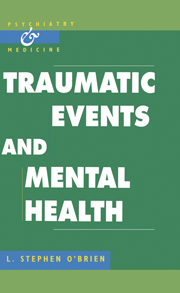Book contents
- Frontmatter
- Contents
- Foreword
- 1 Introduction and historical perspective
- 2 Normal reactions to trauma
- 3 Epidemiology of post-traumatic stress disorder and post-traumatic illness
- 4 Aetiology and predisposing factors
- 5 What constitutes a stressor?
- 6 Post-traumatic illness other than post-traumatic stress disorder
- 7 Diagnosis and assessment
- 8 Management and outcome of post-traumatic illness
- 9 Medicolegal aspects of post-traumatic illness
- 10 Prevention of post-traumatic illness
- 11 The way ahead – whither now?
- Index
8 - Management and outcome of post-traumatic illness
Published online by Cambridge University Press: 05 May 2010
- Frontmatter
- Contents
- Foreword
- 1 Introduction and historical perspective
- 2 Normal reactions to trauma
- 3 Epidemiology of post-traumatic stress disorder and post-traumatic illness
- 4 Aetiology and predisposing factors
- 5 What constitutes a stressor?
- 6 Post-traumatic illness other than post-traumatic stress disorder
- 7 Diagnosis and assessment
- 8 Management and outcome of post-traumatic illness
- 9 Medicolegal aspects of post-traumatic illness
- 10 Prevention of post-traumatic illness
- 11 The way ahead – whither now?
- Index
Summary
There is a definite paucity of empirical data about the treatment and the outcome of PTI other than PTSD and acute stress disorder. In acute stress disorder the data are sparse and mostly based upon either intervention in combat stress disorder, or on uncontrolled trials or case data.
Even in the most closely studied area, that of PTSD, there is insufficient evidence to say that there is a single specific treatment strategy which is the most appropriate to be used in every case or in the typical case of PTSD. In the same way, there is considerable controversy about the prognosis in PTSD.
ICD-io suggests that PTSD is essentially of good prognosis (World Health Organisation, 1992) when it says ‘the course is fluctuating but recovery can be expected in the majority of cases’.
However, it also points out that ‘in a small proportion of patients the condition may show a chronic course over many years and a transition to an enduring personality change’. It is suggested, therefore, that PTSD may precede a type of personality change which is ‘a chronic, irreversible sequel of stress disorder’. The notes to the specific diagnosis in ICD-io indicate that such a change should only be diagnosed following extreme and prolonged traumatic events and not following brief life-threatening experiences such as road traffic accidents. The diagnostic guidelines are somewhat vague. The prognosis for this condition, which is not present in DSM-IV but is akin to the concept of DESNOS (Worzel, 1992), is effectively of inevitable poor prognosis as it is necessary for the changes in personality to have been present for two years before the diagnosis can be made, and because it is described as ‘enduring’.
- Type
- Chapter
- Information
- Traumatic Events and Mental Health , pp. 209 - 241Publisher: Cambridge University PressPrint publication year: 1998

